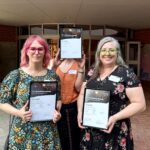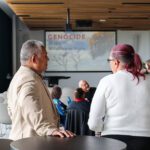Reading time: 3 minutes
This year, the John Curtin Prime Ministerial Library (JCPML) has been commemorating significant events from eighty years ago in the exhibition ‘1945: The Price of Peace’. We conclude the year with Remembrance Day on 11 November, which also happens to be the date of this year’s JCPML annual lecture.
Remembrance Day reflects the armistice marking the end of hostilities of World War 1 at 11am on 11 November 1918. From 1919 until 1945, the commemoration was known as Armistice Day. In 1946, Commonwealth nations adopted the name ‘Remembrance Day’ to include those killed in the Second World War and later conflicts. It became known informally as ‘Poppy Day’. Poppies grew on the Western Front during the World War 1 and, inspired by the poem ‘In Flanders Fields’ by John McCrae, were worn on Armistice Day in the years following the war as a fundraiser for veterans.
Another key aspect of Remembrance Day is the observance of a period of silence in memory of the dead. The idea was first put forward by an Australian journalist, Edward Honey (1885-1922), who had served in the First World War. Working in England, he published an article in 1919 asking, ‘Can we not spare some fragment of those hours of Peace rejoicing, for a silent tribute to these mighty dead?’ His suggestion was for five minutes of silence, but this proved to be too long. King George V requested two minutes’ silence to be observed on the first anniversary of the Armistice in 1919, and the tradition began. (Argus, 10 November 1945, p. 3)
Sunday 11 November 1945 was the first peace-time Armistice Day in Australia since 1938. It was a day of reflection and ceremony. In Perth, members of the services laid wreaths in memory of the fallen at the State War Memorial in King’s Park. The Observatory gun was fired at 11am and again 2 minutes after. The Last Post was played by buglers on Perth intersections, preceding two minutes of silence, followed by the sounding of Reveille. Ben Chifley, who had succeeded to the prime ministership after John Curtin’s death in July, attended a service in his home-town of Bathurst in New South Wales. At the Australian War Memorial in Canberra, there was a ‘brief, simple and impressive ceremony, in which remembrance of those fallen in two wars offered poignant reflections for all who had fought and lived through the last six years of stress’. A more elaborate ceremony was held in London where a crowd of 5000 gathered at Albert Hall and the event was ‘brought to a solemn climax with a shower of red poppy petals from the roof’ (Canberra Times, 12 November 1945, p. 2.).
‘The Price of Peace’ exhibition includes photographs, archival documents and magazines conveying something of the spirit of the time as a nation mourned its losses and looked forward to a brighter future. It can be viewed on Level 3 of the TL Robertson Library for a short time longer.
The 2025 JCPML lecture will be given by federal education minister, Hon. Jason Clare, MP. The event is at Curtin University’s Elizabeth Jolley Lecture Theatre, starting at 4:30pm, 11 November 2025. Tickets are free, but registration is required.
Photograph: Crowd at State War Memorial, King’s Park, 1945, State Library of Western Australia, 221525PD.
Written by Sally Laming, Library Special Collections Coordinator



